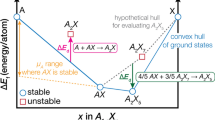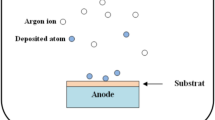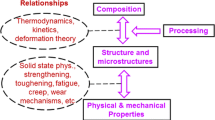Abstract
The surface structures and relative stabilities of low-miller-index surfaces of γ-TiH and γ-TiH2 have been investigated as a direct function of environmental conditions (hydrogen partial pressure pH2 and temperature T), using the first-principles thermodynamic calculations. The results were used to construct the surface phase diagrams for a wide pH2 range at T = 300 and 900 K. The γ-TiH surfaces tend to be dominated by the non-stoichiometric (110) at low pH2 values, and the most energy-favored surface termination would change from the 110-ns-2Ti1H to the 110-ns-2Ti2H and then to the 110-ns-2Ti4H as pH2 increases. For pH2 > e−43.6 at 300 K (or pH2 > e−2.5 at 900 K), γ-TiH can no longer be stable but have the tendency to transform into γ-TiH2, by consistently absorbing H from the gaseous environment. The γ-TiH2 surfaces tend to be dominated by the stoichiometric (111) facet with the 111-stoi-2H termination and with a surface energy of 1.31 J/m2.











Similar content being viewed by others
Data and code availability
All data generated or analyzed during this study are included in this published article and its Supplementary Information file.
References
Lütjering G, Williams JC (2007) Titanium, 2nd edn. Springer, Heidelberg
Manchester FD, San-Martin A (1987) The H-Ti (Hydrogen–Titanium) system. Bull Alloy Phase Diagr 8:30–42
Tao SX, Notten PHL, Van Santen RA, Jansen APJ (2009) Density functional theory studies of the hydrogenation properties of Mg and Ti. Phys Rev B 79:144121
Wang XQ, Wang JT (2010) Structural stability and hydrogen diffusion in TiHx alloys. Solid State Commun 150:1715–1718
Kolesnikov AI, Balagurov AM, Bashkin IO, Fedotovt VK, Malyshevt VYu, Mironova GM, Ponyatovsky EG (1993) A real-time neutron diffraction study of phase transitions in the Ti–D system after high-pressure treatment. J Phys Condens Matter 5:5045–5058
Wang K, Kong XC, Du JL, Li CH, Li ZL, Wu Z (2010) Thermodynamic description of the Ti–H system. Calphad 34:317–323
Hodgson A (2000) State resolved desorption measurements as a probe of surface reactions. Prog Surf Sci 63:1–61
Sakintuna B, Lamari-Darkrim F, Hirscher M (2007) Metal hydride materials for solid hydrogen storage: a review. Int J Hydrog Energy 32:1121–1140
Zhang CS, Li B, Norton PR (1996) The initial stages of interaction of hydrogen with the Zr (1010) surface. Surf Sci 346:206–221
Li FS, Li SL, Yang K, Wang YL (2021) Morphology and microstructure evolution of surface hydride in zirconium alloys during hydrogen desorption process. Int J Hydrog Energy 46:24247–24255
Wang F, Li RF, Ding CP, Tang WK, Wang YB, Xu SM, Yu RH, Wu Y (2017) Recent progress on the hydrogen storage properties of ZrCo-based alloys applied in international thermonuclear experimental reactor (ITER). Prog Nat Sci 27:58–65
Yan G, Chen WD, Zhong XK, Yan SF (2013) Properties of oxide coating on the surface of ZrH1.8 prepared by microarc oxidation with different positive voltages. Rare Met 32:169–173
Ma MW, Liang L, Tang BH, Xiang W, Wang Y, Cheng YL, Tan XH (2015) Decomposition kinetics study of zirconium hydride by interrupted thermal desorption spectroscopy. J Alloys Compd 645:S217–S220
Shen CL, Jia YP, Xu CH, Hu SL, Zhou XS, Long XG (2022) Adsorption and diffusion behavior of hydrogen on the M-doped (M=Zr, Mo, Y, Cu, Pd, Ir, Mg, Al, Si) Ti(0001) surfaces: a first-principles study. Surf Sci 725:122149
Wang L, Zhou F, Meng YS, Ceder G (2007) First-principles study of surface properties of LiFePO4: surface energy, structure, Wulff shape, and surface redox potential. Phys Rev B 76:165435
Kiejna A, Lundqvist BI (2001) First-principles study of surface and subsurface O structures at Al (111). Phys Rev B 63:085405
Yang LT, Jiang Y, Odette GR, Zhou WC, Liu ZM, Liu Y (2013) Nonstoichiometry and relative stabilities of Y2Ti2O7 polar surfaces: a density functional theory prediction. Acta Mater 61:7260–7270
Sun SP, Li XP, Wang HJ, Jiang Y, Yi DQ (2016) Adsorption of oxygen atom on MoSi2 (110) surface. Appl Surf Sci 382:239–248
Liang CP, Gong HR (2010) Structural stability, mechanical property and phase transition of the Ti–H system. Int J Hydrog Energy 35:11378–11386
Xu QC, Van-Der-Ven A (2007) First-principles investigation of metal-hydride phase stability: The Ti-H system. Phys Rev B 76:064207
Ukita S, Ohtani H, Hasebe M (2007) Thermodynamic analysis of the Ti-H and Zr-H binary phase diagrams. J Jpn I Met 71:721–729
Shanavas KV, Lindsay L, Parker DS (2016) Electronic structure and electron-phonon coupling in TiH2. Sci Rep 6:28102
Shimizu R, Sasahara Y, Hamada I, Oguchi H, Ogura S, Shirasawa T, Kitamura M, Horiba K, Kumigashira H, Orimo S, Fukutani K, Hitosugi T (2020) Polarity reversal of the charge carrier in tetragonal TiHx (x=1.6–2.0) at low temperatures. Phys Rev Res 2:033467
Billeter E, Łodziana Z, Borgschulte A (2021) Surface properties of the hydrogen–titanium system. J Phys Chem C 125:25339–25349
Shen CL, Liu Y, Gong YX, Liu ZQ, Jiang Y, Xu CH, Zhou XS, Long XG (2022) Environment-dependent phase stabilities of titanium hydrides: a first-principles prediction. T Nonferr Metal Soc, in press
Siegel DJ, Hector LG, Adams JB (2003) Ab initio study of Al-ceramic interfacial adhesion. Phys Rev B 67:092105
Jiang Y, Smith JR, Evans AG (2008) First principles assessment of metal/oxide interface adhesion. Appl Phys Lett 92:141918
Jiang Y, Smith JR (2009) Pt effects in γ-Ni(Al)/α-Al2O3 adhesion. J Mater Sci 44:1734–1740https://doi.org/10.1007/s10853-008-3084-1
Jiang Y, Wei YG, Smith JR, Hutchinson JW, Evans AG (2010) First principles based predictions of the toughness of a metal/oxide interface. Int J Mater Res 101:8–15
Biswas A, Siegel DJ, Wolverton C, Seidman DN (2011) Precipitates in Al-Cu alloys revisited: atom-probe tomographic experiments and first-principles calculations of compositional evolution and interfacial segregation. Acta Mater 59:6187–6204
Lan GQ, Jiang Y, Yi DQ, Liu SJ (2012) Theoretical prediction of impurity effects on the internally oxidized metal/oxide interface: the case study of S on Cu/Al2O3. Phys Chem Chem Phys 14:11178–11184
Kressese G, Furthmüller J (1996) Efficiency of ab-initio total energy calculations for metals and semiconductors using a plane-wave basis set. Comp Mater Sci 6:15–50
Kresse G, Joubert D (1999) From ultrasoft pseudopotentials to the projector augmented-wave method. Phys Rev B 59:1758–1775
Perdew JP, Burke K, Ernzerhof M (1996) Generalized gradient approximation made simple. Phys Rev Lett 77:3865–3868
Togo A, Oba F, Tanaka I (2008) First-principles calculations of the ferroelastic transition between rutile-type and CaCl2-type SiO2 at high pressures. Phys Rev B 78:134106
Gonze X (1995) Perturbation expansion of variational principles at arbitrary order. Phys Rev A 52:1086–1095
There are some very small imaginary frequencies (less than 0.1 THz) predicted for γ-TiH2 along the Γ→ M direction in Fig. 02. Calculation with the LDA functionals shows no imaginary modes, indicating that these very small imaginary frequencies are resulted from the translational symmetry breaking caused by the GGA type functionals (see Developers’ Manual for the PHonon, Ver. 7.0, QUANTUM ESPRESSOTM). These imaginary frequencies was thus ignored and the γ-TiH2 structure can be determined as dynamically stable. Numerous experiments also confirmed γ-TiH2 as a stable bulk phase in Ti-H system for temperatures up to 650 °C (or 923 K) (see Okamoto H (2011) H-Ti (Hydrogen-Titanium). J Phase Equilib Diff 32:174–175
Setyawan W, Curtarolo S (2010) High-throughput electronic band structure calculations: challenges and tools. Comp Mater Sci 49:299–312
Jiang Y, Adams JB, Van-Schilfgaarde M (2005) Density-functional calculation of CeO2 surfaces and prediction of effects of oxygen partial pressure and temperature on stabilities. J Chem Phys 123:064701
Chase MW (1998) NIST-JANAF thermochemical tables, 4th edn. American Institute of Physics, New York
Irikura KK (2007) Experimental vibrational zero-point energies: diatomic molecules. J Phys Chem Ref Data 36:389–397
Ma MW, Wang L, Wang Y, Xiang W, Liu P, Tang BH, Xiao H (2017) Effect of hydrogen content on hydrogen desorption kinetics of titanium hydride. J Alloys Compd 709:445–452
Shimizu R, Sasahara Y, Oguchi H, Yamamoto K, Sugiyama I, Shiraki S, Orimo S, Hitosugi T (2017) Fabrication of atomically abrupt interfaces of single-phase TiH2 and Al2O3. APL Mater 5:086102
Yoshimatsu K, Suzuki T, Tsuchimine N, Horiba K, Kumigashira H, Oshima T, Ohtomo A (2015) Direct growth of metallic TiH2 thin films by pulsed laser deposition. Appl Phys Express 8:035801
Acknowledgements
The authors would like to thank the financial support from the Science and Technology on Reactor Fuel and Materials Laboratory of China, the National Science Foundation of China (No. 52001331), and the National MCF Energy R&D Program of China (No. 2018YFE0306100). The computational resources at the High Performance Computing Center of Central South University and Hefei Advanced Computing Center are also highly appreciated.
Author information
Authors and Affiliations
Contributions
YL performed data curation and writing—original draft. YG performed visualization and data curation. YW contributed to conceptualization and supervision. YJ contributed to conceptualization, methodology, supervision, and writing—reviewing and editing. CS contributed to validation, supervision, and funding acquisition. XZ performed visualization and supervision. XL performed validation and funding acquisition.
Corresponding authors
Ethics declarations
Conflicts of interest
The authors declare that we have no known competing financial interests or personal relationships that could have appeared to influence the work reported in this paper.
Ethical approval
Not applicable.
Additional information
Handling Editor: Ghanshyam Pilania.
Publisher's Note
Springer Nature remains neutral with regard to jurisdictional claims in published maps and institutional affiliations.
Supplementary Information
Below is the link to the electronic supplementary material.
Rights and permissions
Springer Nature or its licensor (e.g. a society or other partner) holds exclusive rights to this article under a publishing agreement with the author(s) or other rightsholder(s); author self-archiving of the accepted manuscript version of this article is solely governed by the terms of such publishing agreement and applicable law.
About this article
Cite this article
Liu, Y., Gong, Y., Wang, Y. et al. Structures and stabilities of titanium hydride surfaces: a first-principles thermodynamic study. J Mater Sci 58, 12236–12250 (2023). https://doi.org/10.1007/s10853-023-08789-6
Received:
Accepted:
Published:
Issue Date:
DOI: https://doi.org/10.1007/s10853-023-08789-6




